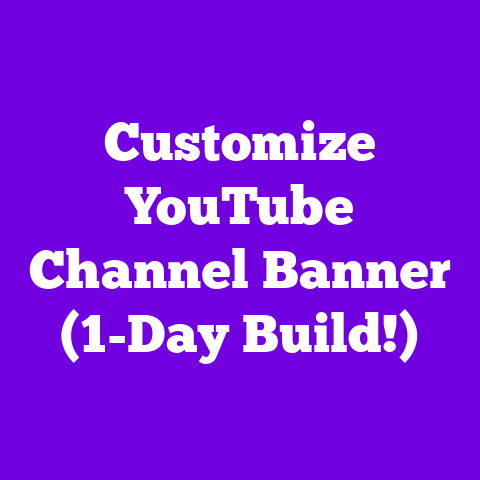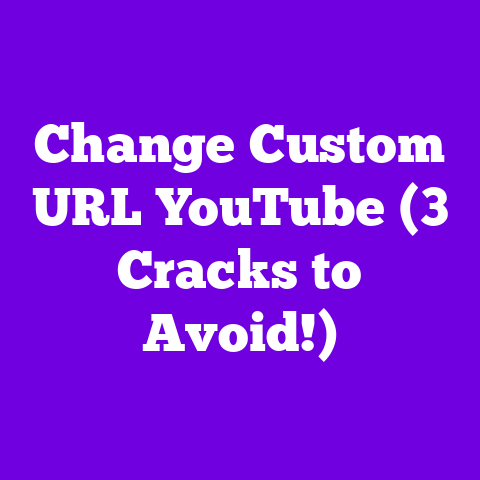Dailymotion vs YouTube Copyright (3-Nail Warning!)
I’ve seen firsthand how a single copyright strike can derail a promising channel.
It’s not just about taking down a video; it’s about reputation, revenue, and the potential death of your creative passion.
That’s why understanding the copyright landscape is absolutely crucial.
In this article, we’re diving deep into the copyright policies of YouTube and Dailymotion, focusing on what you need to know to stay safe in 2025.
We’ll unpack the differences, highlight the potential pitfalls, and give you the inside scoop on how to protect your content and your channel.
Get ready for the “3-Nail Warning!” – a critical aspect of copyright considerations that could save your digital life.
Let’s get started, shall we?
Section 1: Understanding Copyright Basics
Okay, let’s start with the basics.
What exactly is copyright?
Simply put, it’s a legal protection granted to creators of original works, including videos, music, and images.
It gives you, the creator, exclusive rights to control how your work is used, copied, and distributed.
Think of it as your digital shield.
Why is this so important for us content creators?
Because without copyright protection, anyone could steal your content, re-upload it, and even monetize it without your permission.
Imagine spending weeks creating a video, only to have someone else profit from your hard work.
That’s where copyright steps in.
Now, let’s talk about Fair Use.
It’s a legal doctrine that allows limited use of copyrighted material without permission from the copyright holder.
Think of it as the exception to the rule.
But here’s the catch: fair use is a tricky beast, and it’s not always clear-cut.
What factors determine fair use?
- The purpose and character of the use: Is it for educational, criticism, or parody purposes?
- The nature of the copyrighted work: Is it factual or creative?
- The amount and substantiality of the portion used: How much of the original work did you use?
- The effect of the use on the potential market for the copyrighted work: Does your use harm the original creator’s ability to profit from their work?
For example, using a short clip of a movie to critique it in a film review might be considered fair use.
However, using a large portion of a song in your video without permission, even if you give credit, is likely copyright infringement.
It’s a grey area, and it’s always best to err on the side of caution.
Section 2: Dailymotion and YouTube – A Comparison
Let’s take a quick trip down memory lane.
YouTube, founded in 2005, quickly became the dominant video platform, boasting billions of users and a massive library of content.
Dailymotion, launched around the same time, has carved out its own niche, focusing on professional content and a more curated experience.
How have their copyright policies evolved over time?
YouTube, initially plagued by widespread copyright infringement, developed its Content ID system.
This automated system scans uploaded videos for copyrighted material and allows copyright holders to claim revenue, track usage, or even take down infringing videos.
Dailymotion, while also employing content recognition technology, has historically taken a more hands-on approach, relying on both automated detection and manual reviews.
Here’s a table comparing their copyright enforcement methods:
Section 3: The 3-Nail Warning Explained
Alright, let’s get to the heart of the matter: the “3-Nail Warning.” Think of these nails as the critical risks associated with copyright violations.
Ignore them at your peril!
Nail 1: Copyright Strikes
A copyright strike is essentially a warning from a platform that you’ve violated someone’s copyright.
On YouTube, three strikes and you’re out.
Your channel is terminated, all your videos are removed, and you’re barred from creating a new channel.
It’s a digital death sentence.
Dailymotion also has a strike system, but it’s not as widely publicized as YouTube’s.
While they don’t explicitly state a “three strikes” policy, repeated copyright infringements can lead to account suspension or termination.
Here’s some data to consider: According to YouTube’s transparency report, over 99% of copyright issues are resolved through Content ID.
However, that still leaves a significant number of manual claims and strikes.
What happens when you get a strike?
- YouTube: You’ll receive an email notification and a warning on your channel dashboard.
You’ll need to complete Copyright School, a short educational program, to learn more about copyright law.
The strike expires after 90 days, provided you don’t receive any additional strikes. - Dailymotion: You’ll receive a notification, and your video will likely be removed.
The consequences of repeated strikes are less clear, but can ultimately lead to account termination.
Nail 2: Monetization Risks
Even if you avoid a full-blown copyright strike, copyright issues can still impact your ability to monetize your content.
On both YouTube and Dailymotion, if your video contains copyrighted material, the copyright holder can claim the revenue generated by that video.
This is known as a copyright claim (different from a strike).
How does this work in practice?
Let’s say you use a popular song in your video without permission.
The copyright holder can choose to:
- Monetize your video: They’ll run ads on your video and collect the revenue.
- Track your video: They’ll monitor how many people are watching your video.
- Block your video: They’ll prevent your video from being viewed in certain countries or altogether.
On YouTube, you can dispute a copyright claim if you believe it’s inaccurate or based on fair use.
However, the process can be lengthy and complex.
Dailymotion also offers a dispute process, but it may be less transparent.
Nail 3: Legal Ramifications
This is the big one.
Copyright infringement isn’t just a violation of a platform’s terms of service; it’s a violation of federal law.
You could face serious legal consequences, including hefty fines and even criminal charges.
The legal frameworks in place for both platforms are essentially the same, as they both operate under international copyright laws.
However, the likelihood of facing legal action depends on several factors, including:
- The extent of the infringement: How much of the copyrighted material did you use?
- The commercial impact of the infringement: Did your use harm the copyright holder’s ability to profit from their work?
- The intent of the infringer: Did you knowingly infringe on someone’s copyright?
While most copyright disputes are resolved through takedown notices and monetization claims, some cases can escalate to legal battles.
It’s crucial to understand that ignorance of the law is not a valid defense.
Section 4: Case Studies and Real-World Examples
Let’s look at some real-world examples to illustrate these points.
Case Study 1: The Music Mashup
A YouTuber created a mashup of several popular songs, thinking it fell under fair use.
However, the copyright holders of the songs filed copyright claims, and the YouTuber lost all monetization revenue on the video.
The lesson here is that even with transformative works like mashups, you need to be extremely careful about copyright.
Case Study 2: The Gaming Streamer
A gaming streamer on Dailymotion used copyrighted music in their live streams.
The copyright holders issued takedown notices, and the streamer’s account was temporarily suspended.
The streamer learned the hard way that even live content is subject to copyright laws.
I spoke with Sarah, a YouTuber who faced a copyright strike after using a short clip from a TV show in her video.
“I thought it was fair use because I was critiquing the show,” she told me.
“But the copyright holder disagreed, and I got a strike.
It was a wake-up call.
Now, I’m much more careful about using copyrighted material.”
These cases highlight the importance of understanding copyright law and taking proactive steps to protect yourself.
Section 5: Future of Copyright on Dailymotion and YouTube
What does the future hold for copyright enforcement on Dailymotion and YouTube?
Several emerging trends are shaping the landscape.
AI-Powered Copyright Detection: Both platforms are increasingly relying on artificial intelligence to detect copyright infringement.
AI can analyze videos for visual similarities, audio patterns, and even subtle cues that indicate copyright violations.
Blockchain Technology: Blockchain could revolutionize copyright management by providing a transparent and immutable record of content ownership.
This could make it easier for creators to prove their ownership and track the usage of their content.
Decentralized Platforms: As decentralized video platforms emerge, copyright enforcement may become more challenging.
These platforms often operate outside of traditional legal frameworks, making it difficult for copyright holders to protect their rights.
Looking ahead to 2025, I expect to see even more sophisticated AI-powered copyright detection systems, as well as increased adoption of blockchain technology for copyright management.
Creators will need to stay informed about these trends and adapt their strategies accordingly.
Conclusion
Navigating the copyright landscape on Dailymotion and YouTube can be tricky, but it’s essential for protecting your work and maximizing your success.
Remember the “3-Nail Warning”: copyright strikes, monetization risks, and legal ramifications.
The key takeaways are:
- Understand the basics of copyright law and fair use.
- Be aware of the differences in copyright enforcement methods between Dailymotion and YouTube.
- Take proactive steps to protect your content, such as obtaining licenses and using royalty-free music.
- Stay informed about emerging trends in copyright enforcement and digital content ownership.
By being proactive and informed, you can navigate the copyright landscape with confidence and build a successful and sustainable channel.
So, go forth and create, but always remember to protect your work and respect the rights of others.
Good luck out there!





